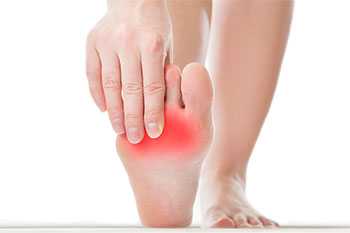
What is Fat Pad Atrophy?
Plantar Fat Pad Atrophy affects the fatty tissue pads which cushion the bones in the ball of the foot. These fat pads thin down with age, which reduces or eliminates their ability to absorb shock and distribute body weight evenly across the foot. These forces then concentrate in the ball of the foot, creating pain and inflammation, along with possible damage to ligaments, nerves, and bones in the surrounding area if not treated properly.
What are the symptoms of Plantar Fat Pad Atrophy?
Plantar Fat Pad Atrophy causes pain and inflammation in the ball of the foot, sometimes giving the sensation of a pebble being stuck in the front of the shoe. This pain typically gets worse when wearing high heels or shoes with thin soles, walking barefoot on hard surfaces, or standing for prolonged periods of time.
Untreated Fat Pad Atrophy may cause damage to ligaments and nerves surrounding the ball of the foot. Additionally, increased pressure may lead to thickened, painful calluses on the ball of the foot and ulcers in the underlying tissue-causing pain in the bones at the base of the toes, and possibly even fractures.
Who is Affected by Fat Pad Atrophy?
Fat Pad Atrophy commonly presents itself in the elderly. Although it can affect both sexes, it can have more impact, and progress more aggressively, in women who wear high heels or tight/narrow shoes, as this type of footwear shifts the body’s center of gravity and places pressure on the balls of the feet.
What Causes Fat Pad Atrophy?
There are several possible causes and contributing factors to Fat Pad Atrophy. Age is the most common cause as fat pads deteriorate with age and do not regenerate. Genetics may also make a person more susceptible to developing this condition as well as wearing high heels or ill-fitting shoes that stress the balls of the feet.
Complications due to diabetes/neuropathy and rheumatoid arthritis can contribute to the formation of Fat Pad Atrophy as well as a previous injury or surgery causing fat pad displacement or deterioration.
Certain gait abnormalities, high arches, chronic steroid use, or depression of the metatarsal bones at the base of the toes may also help Fat Pad Atrophy occur.
How Do You Treat Plantar Fat Pad Atrophy?
A podiatrist may treat Fat Pad Atrophy by prescribing lifestyle and footwear adjustments, or by clinically increasing the cushioning in the ball of the foot.
Lifestyle Adjustments: Any high-impact exercise or repetitive activity that places pressure on the ball of the feet should be avoided, and switched out with low-impact/non-weight-bearing activities.
Footwear Adjustments: Walking barefoot should be avoided-especially on hard surfaces. Any heels that exceed 1 inch should not be worn. Footwear should fit properly, and have ample room in the toe box, and proper support and cushioning. Custom orthotics may be created to provide shock absorption and distribute body weight more evenly across the feet.
Increasing Cushioning in the Ball of Foot: A podiatrist may use a collagen derma-filler such as Sculptra to increase volume and create natural, comforting cushioning in the ball of the foot.
Sculptra was FDA approved for cosmetic use in 2009. In Fat Pad Atrophy correction, the synthetic liquid (containing no human or animal DNA derivative) is injected into the ball of the foot to reduce pain and increase tissue volume. Many patients feel relief within the first application-which typically is all that is necessary, depending on the level of fat pad deterioration.
Within 90 days, the body may begin to produce additional collagen on its own, which further increases the comfort and volume in the ball of the foot, lessens callus formation, and reduces foot fatigue and muscle cramping. Comforting results can typically be maintained with only one annual procedure, depending on the correction that is necessary.
This safe, minimally invasive procedure is followed by minimal downtime, with little-to-no side effects (which are short-lasting if they occur at all). Slight bruising and swelling are normal and lasts usually only one week. In very rare cases, if small, invisible bumps temporarily develop, they usually resolve on their own or can be remedied with anti-inflammatory medication.
